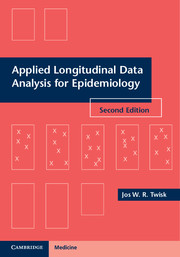Book contents
- Frontmatter
- Contents
- Preface
- Acknowledgements
- 1 Introduction
- 2 Study design
- 3 Continuous outcome variables
- 4 Continuous outcome variables – relationships with other variables
- 5 The modeling of time
- 6 Other possibilities for modeling longitudinal data
- 7 Dichotomous outcome variables
- 8 Categorical and “count” outcome variables
- 9 Analysis of experimental studies
- 10 Missing data in longitudinal studies
- 11 Sample size calculations
- 12 Software for longitudinal data analysis
- 13 One step further
- References
- Index
13 - One step further
Published online by Cambridge University Press: 05 May 2013
- Frontmatter
- Contents
- Preface
- Acknowledgements
- 1 Introduction
- 2 Study design
- 3 Continuous outcome variables
- 4 Continuous outcome variables – relationships with other variables
- 5 The modeling of time
- 6 Other possibilities for modeling longitudinal data
- 7 Dichotomous outcome variables
- 8 Categorical and “count” outcome variables
- 9 Analysis of experimental studies
- 10 Missing data in longitudinal studies
- 11 Sample size calculations
- 12 Software for longitudinal data analysis
- 13 One step further
- References
- Index
Summary
Introduction
In the foregoing chapters, different techniques for longitudinal data analysis were described and illustrated. In these chapters a distinction was made between the analysis of continuous, dichotomous, and categorical outcome variables. In this chapter, some “new” features for longitudinal data analysis will be introduced. In Section 13.2 longitudinal data analysis with outcome variables with upper or lower censoring will be discussed, while in Section 13.3 a short introduction will be given of the analysis aiming to classify individuals with the same developmental trajectories. Because it basically goes beyond the scope of this book, both explanations will be relatively short and basic, but many references will be given in which more detailed and/or mathematical information can be found.
Outcome variables with upper or lower censoring
Introduction
In Section 9.2.1 several possibilities were discussed to define the change in a particular continuous outcome variable over time. It was suggested that for a longitudinal study in which the outcome variable reaches either a ceiling or a floor a different definition of change should be used. When the development over time is analyzed in a particular continuous outcome variable, it is quite common that the variable reaches either a ceiling or a floor. For instance, in rehabilitation research, most of the patients will recover after a certain amount of time. On the instrument to measure the rehabilitation process, these patients cannot score any higher than the maximum. It is also possible that so-called floor effects occur. For instance, when pain medication is investigated and the outcome variable pain is measured on a visual analog scale, some patients will report “no pain” after a certain amount of time. They cannot score lower than the “no pain” level.
- Type
- Chapter
- Information
- Applied Longitudinal Data Analysis for EpidemiologyA Practical Guide, pp. 292 - 304Publisher: Cambridge University PressPrint publication year: 2013



